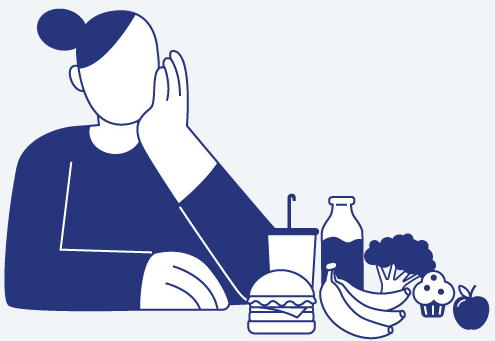Coping strategies for Women with ADHD
Disordered eating
Adults with ADHD symptoms are at higher risk of experiencing disordered eating, which is defined as a pattern of eating behaviour that is not within the normal range, but does not yet meet the criteria to be considered an eating disorder.
Symptoms of ADHD in adults have been correlated with both binge and restrictive eating. More specifically, females with ADHD may be at an increased risk of developing certain eating disorders.
Disordered eating

A study showed that more women with ADHD
suffered from bulimia nervosa compared
to women without ADHD.The inattentive symptoms of ADHD seem
correlated with the severity of bulimia nervosa.The inattentive, hyperactive and impulsive
symptoms of ADHD seem correlated with
binge eating and restrictive eating.
A health care provider well-versed in both ADHD and eating disorders could help you get a better handle on the symptoms of an eating disorder.
Bulimia nervosa is defined as a cycle of eating large amounts of food in a discrete period of time, with a loss of control over eating, followed by compensatory behaviours such as purging.
Binge eating is defined as eating an unusual amount of food in a short and specific period of time.
Avoidant/restrictive food intake disorder is characterized by avoidance or restriction of food leading to failure to meet nutritional and/or energy requirements. This may result in weight loss, nutritional deficiency, dependence on enteral feeding, or oral nutritional supplements or interference with psychosocial functioning.
Mood disorders
Mood disorders are characterized by extreme changes in mood. A person can experience extreme happiness and sadness on the same day. Mood disorders include depression, mania and bipolar disorder.
Patients with bipolar disorder and major depressive disorder are more likely to have ADHD than the general population.
When it comes to women with ADHD, higher mood disorders and emotional dysregulation rates complicate the diagnosis. These women can be diagnosed with a mood disorder when in fact the underlying cause may be ADHD.
This is why patients with mood disorder should be screened for ADHD.
Body dysmorphia
Body dysmorphia is a body-image disorder where one has constant and intrusive preoccupations with an imagined or slight perceived flaw in their appearance.
Unmanaged ADHD symptoms may increase susceptibility of both adult men and women to feelings of negative body image, with women experiencing higher rates of negative body image overall.
Adolescents and young adults with ADHD are at an increased risk for depression symptoms. Since negative body image and depression are related, negative body image may contribute to the relationship between depression and ADHD symptoms. When both are combined, this can contribute to eating disorder symptoms.
Body dysmorphia

Trouble Sleeping with ADHD?
Sleep-related problems in ADHD, such as finding it harder to fall asleep, are common. Some medicines used to treat ADHD symptoms may contribute to the issue.
Why you shouldn’t take it lying downUnderstand Your Options
When you have ADHD, learning about the different treatment options and resources available is an important step in figuring out a treatment plan that’s right for you.
Take steps to make a planNeed Help Talking to Your Doctor about ADHD?
Are you reviewing a current ADHD treatment plan, or exploring a possible ADHD diagnosis for the first time? Our Doctor Discussion Guides can help you get the conversation started.
Doctor Discussion Guides
